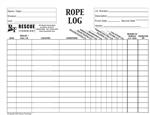

Synthetic fiber ropes will show a reduction in strength when used at elevated temperatures. The friction from this slippage causes localized overheating which can melt or fuse synthetic fibers or burn natural fibers, resulting in severe loss of tensile strength. When using ropes on a capstan or winch, care should be exercised to avoid surging while the capstan or winch head is rotating. Consult the manufacturer for recommendations as to the size and type of rope for the proposed continuous heat exposure conditions. When using rope where temperatures exceed 140° F (or if it is too hot to hold). Heat can seriously affect the strength of rope. When a working load has been used to select a rope, the load must be handled slowly and smoothly to minimize dynamic effects and avoid exceeding the provision for them.Īvoid overheating. Excessive dynamic loading of a high elongation rope is equally dangerous, because of stored energy which will cause the rope to recoil dangerously if it breaks. Users should be aware that dynamic effects are greater on a low elongation rope such as manila than on a high elongation rope such as nylon, and greater on a shorter rope than on a longer one. However, working loads as given do not apply in all such applications as towing lines, life lines, safety lines, climbing ropes, or the like. In extreme cases, the force put on the rope may be two, three, or even more times the normal load involved.Įxamples could be picking up a tow on a slack line or using a rope to stop a falling object. The more rapidly or suddenly such actions occur, the greater this increase will be. Whenever a load is picked up, stopped, moved or swung, there is an increased force due to dynamic loading. Working loads are not applicable when rope is subject to significant dynamic loading. Shock loading can cause failure of a rope normally strong enough to handle the load. Avoid sudden strains where shock loads can exceed breaking strength. Sudden strains or shock loading can cause failure.


 0 kommentar(er)
0 kommentar(er)
